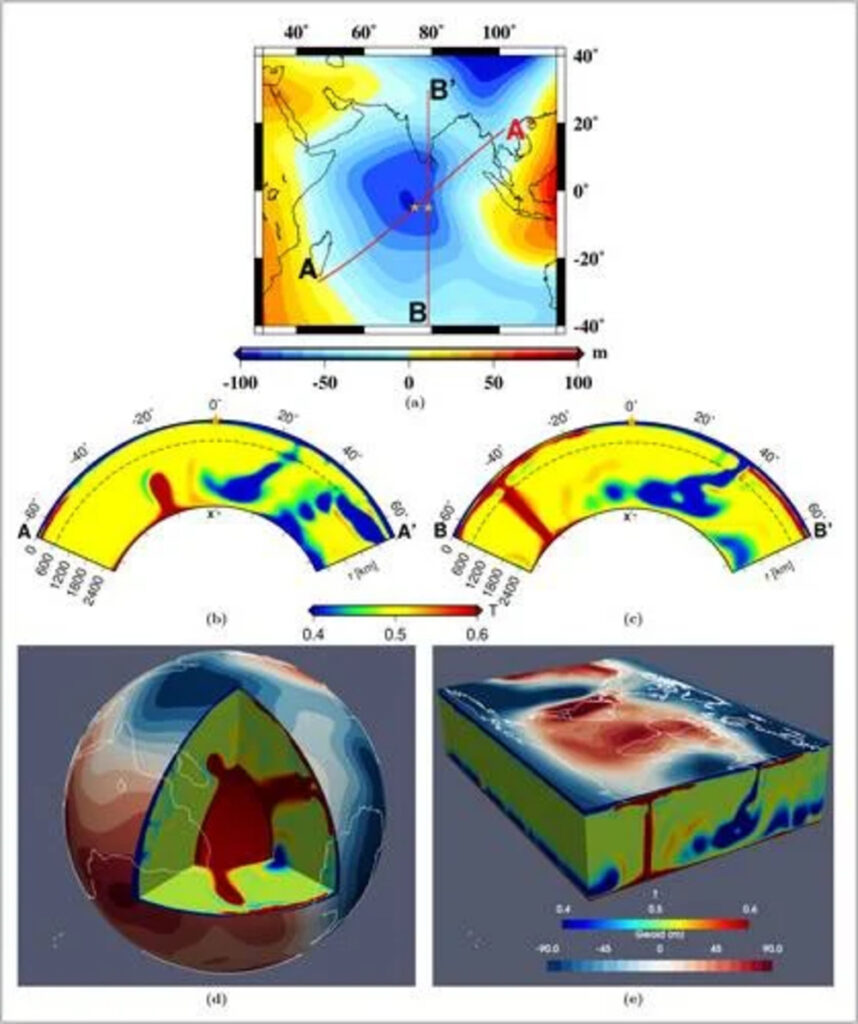Visualize a unique spot in the expansive Indian Ocean where gravity feels notably lighter compared to the rest of the planet. This phenomenon, dubbed the Indian Ocean Geoid Low (IOGL), has intrigued scientists for years, and a recent study has finally shed light on this enigmatic gravitational deviation.
Unearthing the Ocean’s Gravitational Mystery
Deep beneath the Indian Ocean lies a striking gravitational anomaly—a true void in the gravitational field. In this particular region, the sea level dips around 106 meters lower than neighboring waters, creating the impression of an unseen force drawing the ocean downwards. This perplexing phenomenon has sparked curiosity among researchers for ages, prompting a fundamental question: What causes gravity to behave so peculiarly in this locale?
For an extended period, no satisfactory explanation was available. However, a recent study published in Geophysical Research Letters has begun to unravel the enigma. Utilizing sophisticated simulations, the research indicates that this gravitational anomaly may trace its roots back over 140 million years.
Earth’s Uneven Shape: A Cosmic “Potato”
When envisioning Earth, most people picture a flawlessly round sphere. However, the reality is far more intricate. The Earth’s mass is distributed unevenly, resulting in fluctuations in gravity across the globe. In essence, Earth resembles a cosmic potato—its surface is irregular, with certain regions exerting a stronger gravitational pull than others.
The Indian Ocean Geoid Low stands out as one of the most pronounced instances of this gravitational inconsistency. Previous theories regarding its origin, including the idea of an ancient submerged tectonic plate, often fell short of explaining this phenomenon. A breakthrough emerged from a research team led by Professor Attreyee Ghosh at the Centre for Earth Sciences in Bangalore.
By employing state-of-the-art computational modeling and comprehensive seismic analysis, Ghosh and her team pinpointed the source of this anomaly: a significant upwelling of warm and light materials from the Earth’s mantle. This process is linked to a mantle plume, a column of molten rock that extends beneath Africa and spreads into the Indian Ocean.

An Echo of a Lost Ocean
The tale of the IOGL doesn’t merely conclude with the mantle’s dynamics. Its origins may date back to a time when India and Asia were separated by a vast ocean. Approximately 140 million years ago, the Indian plate began its slow drift northward, effectively closing off the ancient ocean. As this ocean vanished, the tectonic plate beneath it began to subduct, or sink, into the Earth’s depths. This phenomenon initiated the eruption of mantle plumes, causing less dense magma to rise from deep within the Earth, creating the gravitational dip we observe today.
To validate this theory, researchers conducted 19 different simulations tracking the movements of the Earth’s mantle over time. In six of these simulations, a geoid anomaly similar to the IOGL emerged, bolstering the idea that this mechanism plays a crucial role in forming the gravity hole beneath the Indian Ocean.
Revealing Earth’s Ancient Mysteries
This groundbreaking discovery offers invaluable insights into the dynamics that shape our planet and its internal structure. The findings have profound implications for our understanding of plate tectonics, mantle dynamics, and how these processes influence Earth’s gravitational field over millions of years.
As scientists delve deeper into this anomaly and conduct further investigations, we can anticipate more revelations about the hidden forces sculpting our planet. The Indian Ocean Geoid Low is not just a captivating curiosity; it offers a glimpse into the complex forces that have historically shaped our planet and will continue to do so for eons.
In summary, the discovery of this gravitational void beneath the Indian Ocean serves as a testament to the enduring mysteries of Earth’s interior. It underscores the vast amount of knowledge still to be uncovered about the forces beneath our feet, reminding us that even the most perplexing phenomena harbor intricate stories rooted in our planet’s past.







